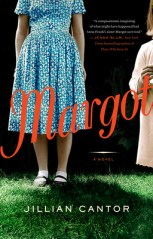“Writing in a diary is a really strange experience for someone like me. Not only because I’ve never written anything before, but also because it seems to me that later on neither I nor anyone else will be interested in the musings of a thirteen-year-old schoolgirl.”
—Anne Frank, June 20, 1942
Experiencing an intense emotional reaction to Anne Frank’s Holocaust diary is hardly unusual. Her stirring account of hiding from Nazis with her family and four other Jews in a cramped Amsterdam annex, has touched countless readers (and has sold more than 30 million copies in 70 languages). When Jillian Cantor first read the book in the early 1990s, she had much in common the young diarist. Cantor was the same age as Anne; also Jewish, and also an aspiring writer.
But when Cantor, now a published author, reread the diary almost 20 years later, found herself closely identifying with a person barely mentioned in the diary: Anne’s older sister Margot. Cantor (an older sister herself) discovered that little was known about the silent and serious Margot beyond her 1945 death, a few days before Anne’s, in the infamous Bergen-Belsen concentration camp.
Margot, it turns out, also kept a diary, which was sadly lost in the chaos of war.
Cantor knew she wanted to explore this facet of the Frank story—and was energized at the idea of drawing on a blank slate. The result is her compelling novel, Margot, which goes on sale Tuesday, September 3, by Riverhead Books. The author has imagined an alternative fate for Margot, in which she escapes captivity alone, and years later, makes her way to Philadelphia as Margie Franklin The book takes place in 1959, with Margot still traumatized by her wartime ordeal. She wears a sweater at all times, intended to cover up the hated—and identifying-concentration camp tattoo. She denies her Judaism, and will not disclose her identity as Anne’s sister. The trauma of her captivity causes as much confusion for Margot as might be imagined. Horrific memories interrupt her days and nights.
* * * *
The book’s publication raises some interesting questions, chief among them: How much can an artist “borrow” from the life of a real person? That Cantor’s creation perished in the Holocaust—and happens to be connected to a work that is both a beloved literary work and an important historical document only complicates the issue.
Rather than dying a tragic death, Margo has been whisked away to Philadelphia, where she is a withdrawn legal secretary, secretly in love with her Jewish lawyer boss. She suffers the (imagined) flashbacks and conflicts of someone who has watched her closest family members suffer the horrors of the Holocaust. Is it too unsettling to employ Margot as a tabula rasa, obsessed with her totally imagine romance with Peter van Pels, a teenage boy who shared her captivity? But some of Cantor’s speculations seem justified: survivor’s guilt and sibling rivalry with the all-but-sainted Anne.
* * * *
TIME was given an exclusive interview with Cantor, in which she described her unique literary project. Was she worried about treading on what many readers consider sacred text? Only after the fact, it seems. “There’s been so much written about Anne over the years: fiction and nonfiction, and plays, and movies, and so many editions of her diary,” she says. “And she’s appeared in fictional works. But really nothing has been written about Margot. I had a very hard time finding anything about her. So I felt like I wanted to tell her story and when I was writing, I didn’t think about anybody reading it. I didn’t think about what other people would say. I just sort of thought “well this is a story that I need to tell. And this’d be a book I would want to read.” And then after the fact, people have been asking me that. And I see that, but at the time when I was writing it, I didn’t really think about that.”
But the reader immediately encounters a challenge: what is real and what is not? Says Cantor, “I was writing about this person in this time where she never existed, doing things that she never actually did, and it was just sort of my imagining of her in that time. Now, there are scenes in the book that do take place in the Annex and for that, I was fictionalizing based on what I read. And of course we don’t know. We weren’t there. We don’t really know what happened. And I think, I hope that I did it in a way that was fair to the characters and sensitively done. And I tried to do that, at least.” For the reader who makes it to the author’s note at the end, that question is finally answered: much of the book is heart-felt, convincing invention.
We had a few quibbles with the book—Cantor, for example, veers to close to romance-novel territory in describing Margot’s love interests—but the author mostly succeeds in her daunting endeavor. It is an understandable, and even commendable goal, as Cantor puts it in her author’s note, “to give back what was stolen from Margot, even if only in a fictional world: her voice, her life, her happy ending.“
On Tuesday, Sept. 3, TIME.com will present an excerpt from Jillian Cantor’s Margot.


